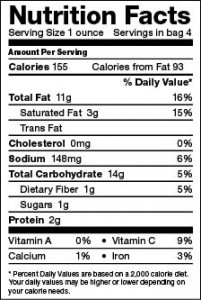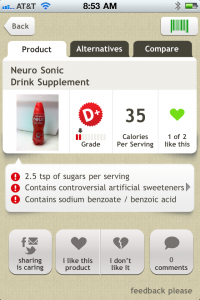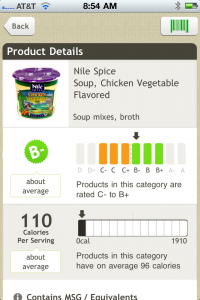Fooducate Yourself
I like food labels. The more I know about what I am eating the better. When I know more, I eat better. I have to. Like most Americans, I struggle with my weight. It seems like I have to work out just to stay 15 pounds overweight. Anything that can arm me with more information about what I am eating is OK with me. I like reading the information on the back of the box and I absolutely love that restaurants must list the calorie count of the food they sell.
That’s why I got excited when I saw Fooducate, an iPhone app. With Fooducate you scan the bar code on the package and it reveals a ton of good information about what is in that package of chips or bottle of juice. If you are a food label geek like me, or just want handy tool for buying better food, this is a great app. And if you are a mobile app geek, this app is a great example of how to build a location based app. If you are trying to lose weight I would add this to the tool chest.
Did someone say food label geek? Before I get to the app let’s take a look at why we label food and put calories on menus. The short answer is because the government makes us. Here is the geekier answer.
Government food labeling covers packaged food and more recently, food that is served at restaurants. The packaged food labeling laws came first. In 1990 Congress mandated nutrition labeling on packaged food sold to the public, building on the ingredients already listed on the food. The main reason was to inform the public of what is in the food they are eating after being subjected to years of relentless and persuasive marketing campaigns that often made dubious health claims about food. These laws have been updated over the years resulting in the graphic on the back of the package that lists all the details of the food. Called the nutrition facts label, it shows the details of what you are eating as a measure of the total calories, fat, saturated fat, cholesterol, sodium, total carbohydrates, sugars, fiber and total protein a serving of the food provides based on the magical 2000 calorie diet most Americans (should) eat every day. You have probably seen them and ignored them, like most people.
Informing the citizenry about the crap they put on the family plate is such fun why stop at packaged goods? Restaurant food is a gold mine of misinformed eaters, right? Local governments at the state and city county level, like Seattle, have been passing laws making restaurants list the caloric value of the foods on the menu. You many have noticed around the Northwest menus in restaurants listing the calories of the food. Since these were mostly local efforts, these laws created some confusion for chain restaurants that operate in multiple states.
Leave it so the Federal Government to add clarity. In 2010, the President Obama signed the health care reform legislation into law. Section 4205 of the Patient Protection and Affordable Care Act requires restaurants and similar retail food establishments with 20 or more locations to list calorie content on restaurant menus and menu boards, including drive-through joints.
When I initially heard about the laws forcing restaurants to list calories I thought that seemed like government over reach. Many businesses would have to reprint or replace perfectly good menus or signage. The people in the Jack-in-the-Box Drive through getting that forth meal don’t need the number to know they are about to get a calorie bomb dropped on them.
But then a funny thing happened with the calorie law. I discovered I liked it. When I went to the usual sandwich joint near the office I was able to compare the calories of my favorite two sandwiches. I found that one had 200 more calories than the other but was not any more yummy, and I stopped eating it that day.
We can’t deny that we need more help and better information about what we eat. Americans are becoming fatter and sicker. Just look at the data. According to the Centers for Disease Control and Prevention one out of every three adult Americans has high cholesterol and two-thirds of them do not have it under control. It’s killing us. High blood pressure and high cholesterol are two of the major risk factors for heart attacks, strokes and other cardiovascular diseases, which are the leading cause of death in the United States, killing 800,000 people every year. According to the CDC 50.8 million men and 55.9 million women have high blood pressure. Those are real numbers. It’s hard not to think this trend is going to get worse as the boomers continue aging.
If the health issues don’t move you follow the money. Eating cheap food costs real money. High blood pressure and cholesterol related health problems cost the country $300 billion per year – $1 out of every $6 spent for health care. Expect that number to triple in the next 20 years, said Dr. Thomas R. Frieden, the CDC director. “The bottom line is, high blood pressure and cholesterol are out of control.”
Wasn’t this an iPhone app review? Yes. As I mentioned previously, we need help. The numbers don’t lie. Like many of today’s problems, help can be found in the iTunes store (that’s a joke). I have been using Fooducate to help me learn more about the food I buy and eat before I buy it.
Fooducate, a free app, is on my phone so it’s in the grocery store with me when I am shopping. If I want to learn more about some food I simply scan the bar code of the product into the app. The app’s scanner works great and finds the bar code on the package quickly and easily. Then the app pings the Fooducate product database and gets all the important dietary information and shows it on the screen. It’s like the Nutrition Label came alive and got internet access.
Once you scan the bar code Fooducate builds a helpful little infographic about the product. At a glance you get a quick understanding of how healthy the food is because it’s graded…A,B,C etc. You can compare the products to other products simply by scanning them. I found out the Very Vanilla Silk Soy milk we buy gets a B- compared to it’s standard vanilla cousin because of the extra sugar. I scanned a bottle of Powerade, which I know wasn’t good for you but I was surprised it got a D+. If your product gets a low grade the app will give you a list of alternatives that are in the same food product group but get better grades. Triscuits are a bit better than Wheat Thins, in case you were wondering. And a lot more foods have MSG than you would think.
Fooducate is easy to use. I like the app because I was learning about food in the first 2 minutes and didn’t have to sign up for an account or learn some complex UI. Plus the design of the app is quite elegant.
As an app geek I am impressed with how the app uses location. Fooducate is valuable when you are standing in the aisle looking at different products you can do a compare and see which scores the best. It’s in the right moment and in my hand. The app really captures the essence of location based services. And it’s fun. I found myself scanning lots of food I had no intention of buying, just to see what grade it got.
There are a few downsides. First of all when I was in the heart of the grocery store, surrounded by refrigerated aisles I lost my connection. Without the connection the app is worthless. Being able to scan now and learn later might be good a good addition. Unfortunately the app developers felt the need to throw in some dumb “iphone” features. For example, shaking the app for a random product seems gratuitous. I would rather they focus their attention on making the app even easier.
The app also can’t read every bar code, and doesn’t have every product in it’s database. It doesn’t recognize store labeled products or some of the niche products like Jones Soda. But if the app doesn’t have the product it asks for your help, which is neat. The app asks the user to take a picture of the package, the ingredients list and the nutrition label. The ones I submitted came back a few days later. This creates user engagement and investment in the app and is really smart.
Fooducate is fun and a great way to learn about what you are stuffing in your mouth and putting on the plate. And learning more about healthy eating isn’t just a trendy lifestyle choice, it’s more important than that. As a nation we are getting fatter and spending a lot of money getting there (and getting back). We all need simple little tools to help us. Put Fooducate on your iPhone.




Hi Pete, thanks for the thoughtful review.
The reason we implemented “shake for random” was to allow first time users who are not in front of a barcoded food item to experience the app the instant they download it.
In the mobile world, it’s all about instant gratification.
thanks,
Hemi
Co-founder & CEO, Fooducate
That makes a lot of sense. I know what you mean about instant gratification. I’m glad you liked the post.